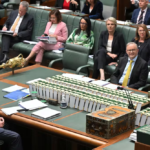HECS-style loan scheme for Paid Parental Leave provides fairness for women and taxpayers
The Abbott government’s proposed Paid Parental Leave scheme remains controversial. Matthew Taylor from the Centre for Independent Studies lays out an alternative to the Coalition’s reforms.
The Australian government spends around $1.4 billion on statutory Paid Parental Leave (PPL) every year, providing payments to more than 130,000 parents of newborns. Current PPL policy provides the primary carer of a newborn with the full-time minimum wage for up to 18 weeks ($11,538).
The Abbott government proposes to increase the parental leave period to 26 weeks and increase the rate of payment to the primary carer’s pre-birth wages up to a cap of $100,000. This will cost the Australian taxpayer over $5 billion by 2016-17.
In the absence of a PPL scheme, some parents would be unable to finance their own parental leave, and not all parents can access PPL workplace entitlements. However, the current scheme provides payments to parents with earnings of up to $150,000. The Coalition’s scheme would cap payments for those earnings above $100,000 removing means testing altogether.
The Abbott government proposes to take a PPL scheme that is already poorly targeted and introduce a taxpayer-funded payment that will use the tax dollars of lower income parents to make payments of $50,000 to those with the highest earnings. Not only does this contradict the objectives of the rest of Australia’s income support system, it will provide the largest payments to those parents most able to finance their own parental leave and those most likely to already have access to the most generous PPL workplace entitlements.
Earlier this week the Centre for Independent Studies released a new report, Fairer Paid Parental Leave, which proposes a fairer alternative to the Coalition’s controversial reforms (a brief visual summary can be found here). The report argues that PPL should be provided through a loans program similar to the Higher Education Contribution Scheme (HECS) for tertiary education.
Under a Parental Leave Contribution Scheme (PLCS) the government would make weekly payments to the parents of newborns up to the primary carer’s pre-birth wage for up to 26 weeks. Working parents with earnings less than the full-time minimum wage would receive the full-time minimum wage just as they would under current PPL policy and the Coalition’s proposal.
Paying back the loan would be the responsibility of both parents, but only those with earnings above the full-time minimum wage would need to make repayments. Like HECS, repayment rates would be progressive so as to ensure that repaying the loan wouldn’t be a burden on low-income families.
A typical family where the mother has annual earnings of $40,000 prior to her first birth and whose partner has annual earnings of $60,000 would pay off a PPL loan in 6 years. Repayments would never exceed 4% of their combined earnings and 89% of the loan would be repaid by the primary earner.
A PLCS would achieve the gender equity objectives of statutory PPL. The progressive repayment rates ensure that it is the higher income parent, who is generally male, who would make most of the repayments, in recognition of the value of the primary carer’s unpaid parenting. The Coalition’s scheme on the other hand is funded by taxpayers, many of whom are women whose careers have been interrupted by child birth.
We need a better PPL scheme for Australian families and working women—a PPL scheme that ensures that all Australian children benefit from parental leave but one that doesn’t push all of the cost onto taxpayers to the benefit of those who least need it.
Matt Taylor is a Research Fellow in the Economics Program at the Centre for Independent Studies (CIS). Prior to joining CIS Matt worked at number of university research institutes and government agencies including the National Centre for Social and Economic Modelling and the Australian Institute of Family Studies undertaking commissioned work for State and Federal Government Departments. His research interests include income support policy, income contingent loans and Australian living standards. Matt has a Bachelor of Economics with Honours from Monash University with specialisations in economics and econometrics. He tweets @mattnomics.













Allan Catlin
July 11, 2014 at 8:54 am
PLCS
A PCLS as outlined by Matt sounds like an idea worth considering. It's interesting although cynical to note that under Abbott's proposed Parental Leave Scheme, the greatest beneficiaries seem to be in the group who might be Liberal voters.